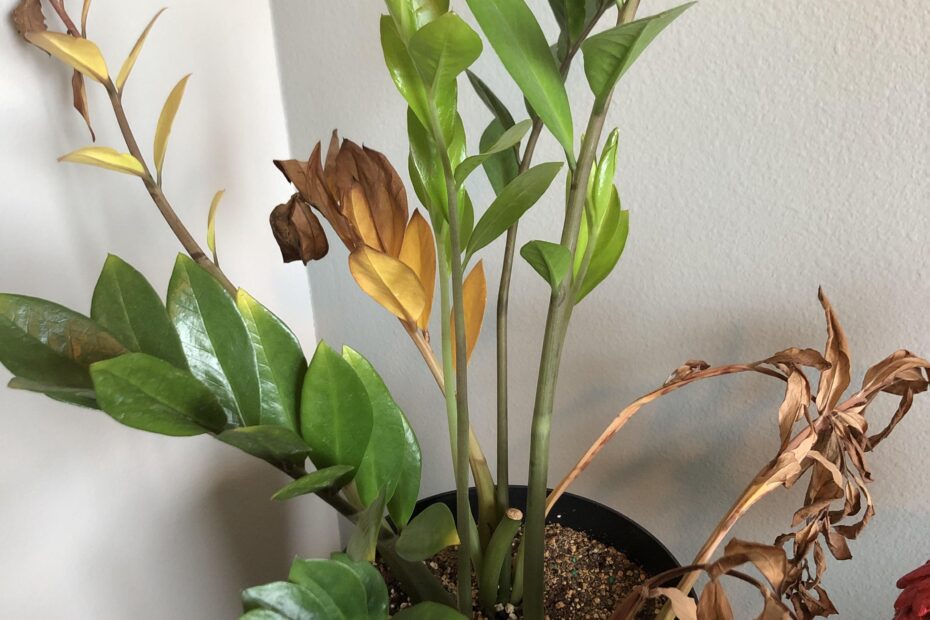The once vivacious, green-leaved sentinel that guarded the corner of your room now appears to have donned a golden-brown veneer, casting a melancholic hue in its wake. Oh, the perplexing enigma of nature! Fret not, fellow plant lover, for our inquisitive minds shall embark on a journey to unravel the mysterious tale behind your ZZ plant’s unexpected transformation. In this quest for enlightenment, we shall delve into the depths of horticultural expertise and seek answers to the age-old question that haunts us all: “Why is my ZZ plant turning brown?” Prepare to unearth the secrets of chlorophyll’s vanishing act, as we navigate through the realms where foliage flirts with shades unknown.

Understanding the common causes behind zz plant browning
When your beloved ZZ plant starts turning brown, it can be disheartening. Fear not, for we have delved into the world of ZZ plants to understand the underlying causes behind this phenomenon. By identifying these culprits, you can take the necessary steps to restore your plant’s vibrant greenery.
One common cause of browning in ZZ plants is overwatering. These tough, drought-tolerant plants thrive in well-draining soil, and excessive moisture can lead to root rot and browning of the leaves. Remember, ZZ plants prefer to dry out between waterings. It’s essential to assess the moisture levels by sticking your finger into the soil about an inch. If it feels dry, it’s time to water. If it’s still moist, resist the temptation to water any further.
Another possible cause of browning in ZZ plants is insufficient light. Although ZZ plants can tolerate low-light conditions, they do need some sunlight to maintain their lush appearance. If your ZZ plant is situated in an area that lacks adequate natural light, consider placing it near a north or east-facing window, where it can receive gentle indirect light. Alternatively, you may opt for artificial grow lights to supplement its light requirements.
| Features | Tips |
|---|---|
| Dark green, waxy leaves | Wipe leaves occasionally to remove dust and promote healthy photosynthesis. |
| Rhizomatous stems that store water | Allow soil to dry between waterings to prevent root rot. |
| Tolerant of low light conditions | Place the plant near a light source or incorporate artificial grow lights to promote its growth. |

Identifying and rectifying issues with watering and humidity levels
One of the most common reasons why ZZ plants turn brown is due to issues with watering and humidity levels. Understanding how to properly care for your ZZ plant can help you identify and rectify these issues, ensuring that your plant thrives and stays healthy.
When it comes to watering your ZZ plant, it’s important to strike the right balance. Overwatering can lead to root rot and brown discoloration, while underwatering can cause the plant to lose moisture and turn brown as well. To avoid these problems, follow the below guidelines:
- Ensure that the top 2 inches of soil are completely dry before watering.
- Use a well-draining potting mix to prevent waterlogged roots.
- Water your plant thoroughly, allowing excess water to drain out from the bottom of the pot.
- During the winter months, reduce watering frequency to avoid overhydration.
In addition to proper watering, maintaining the right humidity levels is crucial for a healthy ZZ plant. ZZ plants are native to tropical regions and thrive in moderate to high humidity. Here are some tips to help you create the ideal humidity environment for your plant:
- Mist your ZZ plant regularly, especially during dry months or when the indoor environment lacks humidity.
- Grouping your plants close together can create a microclimate with higher humidity levels.
- Place a tray filled with water near your plant, so as the water evaporates, it increases the humidity in the surrounding area.
- Consider using a humidifier to control and maintain the humidity levels around your ZZ plant.
By following these watering and humidity tips, you can keep your ZZ plant looking vibrant and healthy, avoiding the common issue of browning. Remember, striking the right balance is key to a thriving ZZ plant, creating an oasis of green in your home. So assess your watering habits, monitor humidity levels, and watch your ZZ plant flourish!
| Features | Tips |
|---|---|
| Brown and dry leaves | Ensure adequate watering and provide higher humidity levels |
| Yellowing leaves | Adjust watering frequency and avoid overwatering |
| Root rot | Use well-draining potting mix and avoid waterlogged conditions |
Addressing potential pest problems affecting your zz plant
ZZ plants are known for their striking green foliage and ability to thrive in low-light conditions. However, if you’re noticing your ZZ plant turning brown, it may be an indication that there’s a potential pest problem lurking. Brown leaves can be a distressing sight, but fear not, as we’re here to address this issue and provide you with essential tips to bring your ZZ plant back to its vibrant self.
One of the primary culprits behind brown ZZ plant leaves is the presence of spider mites. These tiny, eight-legged creatures feed on the plant’s sap, leading to discolored foliage. To combat spider mites, it’s vital to regularly inspect your plant and take prompt action. Here are a few tips to help you fend off these pesky critters:
- Isolation: If you suspect your ZZ plant has spider mites, isolate it from other plants immediately to prevent the infestation from spreading further.
- Insecticidal soap: Use a gentle, organic insecticidal soap to control spider mites. Apply the soap directly to the infested leaves, ensuring complete coverage, and repeat treatment as necessary.
- Humidity increase: Spider mites thrive in dry conditions, so increasing the humidity around your ZZ plant can help deter them. Consider using a humidifier or placing a tray of water near your plant to create a more humid environment.
Another common pest that can harm your ZZ plant is mealybugs. These small, white, cotton-like insects often hide in the plant’s crevices and feast on its sap, leading to brown spots and wilting leaves. Here are a few additional tips to combat the menace of mealybugs:
- Manual removal: Carefully inspect your ZZ plant and manually remove any visible mealybugs using a cotton swab dipped in rubbing alcohol. This method allows for targeted removal without harming the plant.
- Neem oil spray: Neem oil, derived from the neem tree, is an effective natural insecticide. Mix it with water as per the instructions and spray it onto your ZZ plant, covering both the top and bottom of the leaves. Repeat the treatment every few days until the infestation subsides.
- Regular cleaning: Keep your ZZ plant’s foliage clean by gently wiping it with a soft, damp cloth. This practice not only removes dust and debris but also discourages mealybug infestations.
Remember, prevention is always better than treatment when it comes to pest problems. Maintain regular care for your ZZ plant, providing it with proper watering, well-draining soil, and adequate light conditions. By following these tips and staying vigilant, you can address potential pest problems and ensure your ZZ plant remains healthy and vibrant.
Implementing effective strategies to revive and care for a brown zz plant
Reviving and caring for a brown ZZ plant can be a challenging task, but with the right strategies, you can bring back its lush green glory. Brown leaves on a ZZ plant can be a sign of various issues such as overwatering, lack of sunlight, improper drainage, pests, or nutrient deficiencies. By implementing effective strategies, you can address these problems and give your ZZ plant the care it needs to thrive.
To revive your brown ZZ plant, here are some helpful features and tips to consider:
| Features | Tips |
|---|---|
| Brown leaves | Trim: Trim off the brown leaves using clean and sharp pruning shears to promote new growth. |
| Overwatering | Adjust watering: Ensure the soil is never soggy by allowing it to dry out between watering sessions. Adjust watering frequency based on the plant’s needs and the surrounding humidity. |
| Lack of sunlight | Provide light: Place your ZZ plant in a bright location with indirect sunlight. Avoid exposing it to direct sunlight, as it can scorch the leaves. |
By following these tips and tailoring the care to the specific needs of your ZZ plant, you can effectively revive its health and beauty. Remember to consistently monitor your plant’s progress, make adjustments as necessary, and shower it with love and attention. With patience and dedication, your brown ZZ plant can make a rewarding comeback, becoming a vibrant addition to your indoor garden.
Frequently Asked Questions
Q: Why is my ZZ plant turning brown?
A: Unearthing the mysteries behind your plant’s browning leaves!
Q: Is my ZZ plant just being dramatic or is there a genuine reason for its brown leaves?
A: Decoding the signal: The subtle and not-so-subtle reasons for your ZZ plant’s brown hue!
Q: Can I repair my beloved ZZ plant’s brown foliage, or is it a lost cause?
A: Hope sprouts green: Unveiling effective methods to revive your browning ZZ plant and restore its natural glory! As we reach the end of our discovery into the puzzling phenomenon of brown-hued ZZ plants, we stand amidst a forest of intrigue and scholarly curiosity. While the journey may have been littered with moments of concern and uncertainty, fear not, dear readers. For within these words lies the essence of knowledge, hope, and guidance to rekindle the vibrancy of your beloved green companions.
In this quest to decipher the enigma behind the browning ZZ plant, we unveiled an array of culprits lurking in the shadows. From overwatering to inadequate light, these adversaries sought to dim the plant’s emerald splendor. But let us not dismiss the resilience and strength embedded in their very essence! For within every troubled leaf, lies the potential for revival and rejuvenation.
Remember, fellow green enthusiasts, that nature itself is a delicate balance that demands our tender care and vigilance. Take heed of the tales we have shared, for they serve as a beacon of enlightenment in your botanical endeavors. Through our collective understanding, we can guide our majestic ZZ plants towards a brighter chapter, where brown belongs not on their leaves, but perhaps on our favorite chocolate chip cookies.
With a heart brimming with newfound knowledge, it is now time to bid adieu and venture forth into the world of flourishing ZZ plants. Rejoice, for you hold the power to restore vitality and bring forth a verdant utopia within the confines of your very home. So nurture, observe, and be attentive, for your green companions shall thrive under your thoughtful guardianship.
As we conclude this enchanting exploration, let the quest for thriving ZZ plants be ever etched in our horticultural memories. And, remember, dear readers, the vibrant heart of a ZZ plant can flicker and fade, but with the right care and affection, it will always reignite as a testament to the marvels of nature’s resilience.
- When to Put Weed and Feed on Lawn in Michigan - October 16, 2023
- When to Fertilize Potatoes Plants - October 16, 2023
- Can You Plant Clover in the Spring - October 16, 2023
Contents

